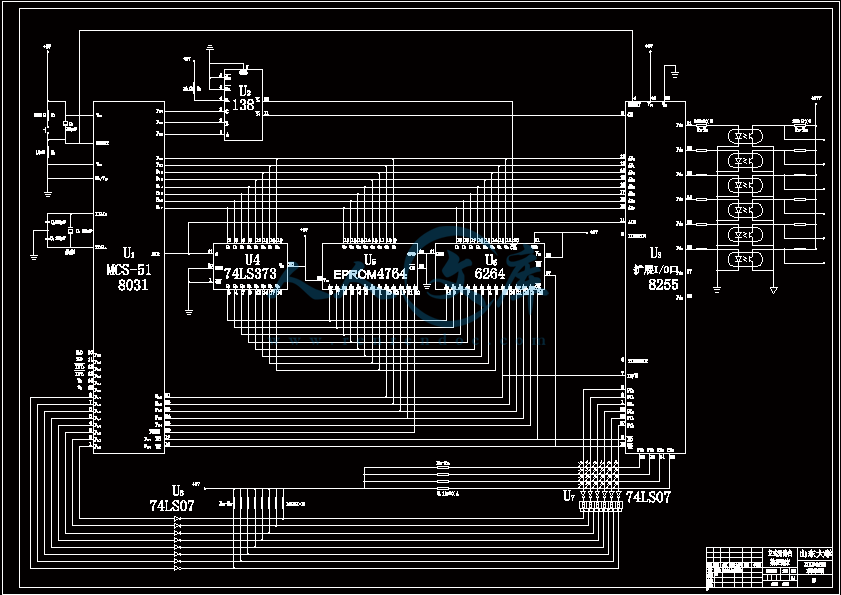摘要
随着人工智能在计算机领域的渗透和发展,数控系统引入自适应控制﹑模糊系统和神经网络的控制机理,不但具有自动编程﹑前馈控制﹑模糊控制﹑学习控制﹑自适应控制﹑工艺参数自动生成﹑三维刀具补偿﹑运动参数动态补偿等功能,而且人机截面极为友好,并且有故障诊断专家系统使自诊断和故障监控功能更趋完善。伺服系统智能化的主轴交流驱动和智能化进给伺服装置,能自动识别负载并自动优化调整参数。直线电机驱动系统以使用化。
三坐标数控铣床的进给运动是数字控制的直接对象,不论点位控制还是连续控制,被加工工件的最后坐标精度和轮廓精度都受到进给运动的传动精度﹑灵敏度和稳定性的影响。为此,要注意以下三点进给运动要求:
(1) 减少运动件的摩擦力。进给系统虽有许多元件,但摩擦阻力主要来自丝杠和导轨,丝杠和导轨结构的滚动化是减少摩擦的重要措施之一。
(2) 提高传动精度和刚度。在进给系统中滚珠丝杠和支承结构是决定其传动精度和刚度的主要部件,因此,必须首先保证它们的加工精度。
(3) 减少运动惯量。进给系统中每个元件的惯量对伺服机构的启动和制动特性都有直接的影响,尤其是处于高速运转的零件,其惯性的影响更大。
设计是在原有普通铣床的基础上,对其进行改造,成为三坐标数控铣床。该机床能通过三轴联动,实现曲线直线等不同的加工路线。
所设计的三坐标数控铣床,三个坐标方向的移动均由步进电机带动,主轴电机采用交流电机,所有电机均由单片机进行控制。
此设计主要对数控铣床的机构进行设计,了解单片机的工作原理,主要有以下几个方面:X、Y、Z工作台的传动机构设计,主要是滚珠丝杠的运用;机床整体结构的设计,了解优缺点,充分考虑主要矛盾,择优选取;单片机控制系统的设计,进一步熟悉其应用。
关键词: 三坐标铣床, 设计计算, 控制系统, 编程
ABSTRACT
As the field of artificial intelligence in computer penetration and development, the introduction of Adaptive Control, CNC fuzzy systems and neural network control mechanism, not only has the automatic feedforward control programming ,Learning Control, Fuzzy Control, Adaptive Control, Parameter Automatic generated three-dimensional tool compensation,features such as motion parameters of dynamic compensation, and human-machine section is extremely friendly, and there is fault diagnosis expert system enables self-diagnosis and fault monitoring functions even better. AC spindle servo system of intelligent servo drive and intelligence into the device can automatically identify the load and automatically adjust the parameters optimized.
Linear motor drive system to use the technology.
D NC milling machine is digitally controlled feed motion of the direct object, regardless of position control or continuous control, the final coordinates of the workpiece to be machined precision and contour accuracy are subject to the movement of the drive into the accuracy of the sensitivity and stability. To this end, we should note the following three feed motion requirements:
(1) Reduce the moving parts of the friction. Although many components into a system, but mainly from the screw and guide rail friction, screw and rolling guide structure is the one of the important measures to reduce friction.
(2) To improve transmission accuracy and rigidity. In the ball screw feed system and the supporting structure is the driving accuracy and rigidity of its major components, therefore, must first ensure their accuracy.
(3) Reduce the movement of inertia. Feed system inertia of each component of the servo start-up and braking characteristics have a direct impact, especially in high-speed operation of the parts, the inertia of more.
General milling machine in the original design is based on the conduct of its transformation into coordinate CNC milling machine. The three-axis machine tool through the linkage, and curve lines, such as different processing routes.
CNC milling machine designed to coordinate the three coordinate directions of movement by the step motor to drive the spindle motor AC motor, all motor control by the microcontroller.
The design of the main body of the CNC milling machine design, understanding of microcontroller works, mainly in the following areas: X, Y, Z table of the driving mechanism, mainly the use of ball screws; machine tool structural design, understanding of strengths and weaknesses, take full account of the principal contradiction, merit selection; microcomputer control system, become more familiar with their application.
Key words: coordinate milling machine, design and calculation, control systems, programming
目 录
第1章 绪论 1
1.1 数控铣床的分类 1
1.2 数控铣床的组成及特征 2
1.3 数控铣床的主要功能及应用 5
第2章 设计主要参数及基本思想 6
2.1 课题要求 6
2.2 设计原则 7
2.3 总结构设计 7
第3章 立式数控铣床的设计和计算 9
3.1 主传动系统的设计 9
3.2 主轴系统计算 14
3.3 进给伺服系统的设计 16
3.4 进给传动的计算 18
第4章 微机控制系统的设计 30
4.1 微机控制系统组成及特点 30
4.2 微机控制系统设备介绍 31
4.3 程序部分 36
结论 40
参考文献 41
致谢 42
第1章 概论
数控铣床是在一般铣床的基础上发展起来的,两者的加工工艺基本相同,结构也有些相似,但数控铣床是靠程序控制的自动加工机床。
1.1数控铣床的分类
1.1.1按主轴布置形式分类
(1)立式数控铣床
????立式数控铣床的主轴轴线与工作台面垂直,是数控铣床中最常见的一种布局形式。立式数控铣床一般为三坐标 ( X 、 Y 、 Z )联动 , 其各坐标的控制方式主要有以下两种:
1 )工作台纵、横向移动并升降,主轴只完成主运动。目前小型数控铣床一般采用这种方式 。
2 ) 工作台纵、横向移动,主轴升降。这种方式一般运用在中型数控铣床中 。立式数控铣床结构简单,工件安装方便,加工时便于观察,但不便于排屑。
(2)卧式数控铣床
卧式数控铣床的主轴轴线与工作台面平行,主要用来加工箱体类零件。一般配有数控回转工作台以实现四轴或五轴加工,从而扩大功能和加工范围。卧式数控铣床相比立式数控铣床,结构复杂,在加工时不便观察,但排屑顺畅。
(3)立卧两用数控铣床
立卧两用数控铣床的主轴轴线可以变换,使一台铣床具备立式数控铣床和卧式数控铣床的功能。这类机床适应性更强,应用范围更广,尤其适合于多品种、小批量又需立卧两种方式加工的的情况,但其主轴部分结构较为复杂。
1.1.2按数控系统的功能分类
(1)经济型数控铣床
经济型数控铣床一般是在普通立式铣床或卧式铣床的基础上改造而来的,采用经济型数控系统,成本低,机床功能较少,主轴转速和进给速度不高,主要用于精度要求不高的简单平面或曲面零件加工。
(2)全功能数控铣床
????全功能数控铣床一般采用半闭环或闭环控制,控制系统功能较强,数控系统功能丰富,一般可实现四坐标或以上的联动,加工适应性强,应用最为广泛 。
(3)高速铣削数控铣床
???? 我们一般把主轴转速在 8000 ~ 40000 r/min 的数控铣床称为高速铣削数控铣床,其进给速度可达 10 ~ 30 m/min,这种数控铣床采用全新的机床结构(主体结构及材料变化)、功能部件(电主轴、直线电机驱动进给)和功能强大的数控系统,并配以加工性能优越的刀具系统,可对大面积的曲面进行高效率、高质量的加工。高速铣削是数控加工的一个发展方向,目前,其技术正日趋成熟,并逐渐得到广泛应用,但机床价格昂贵,使用成本较高。
1.2数控铣床的组成及特征
1.2.1数控铣床的组成
数控铣床的组成及结构如图1.1所示。





 川公网安备: 51019002004831号
川公网安备: 51019002004831号